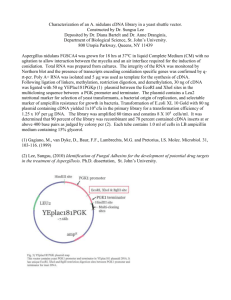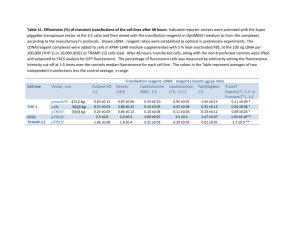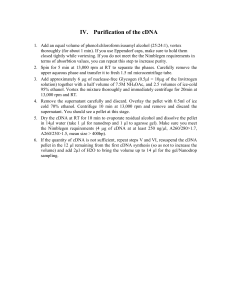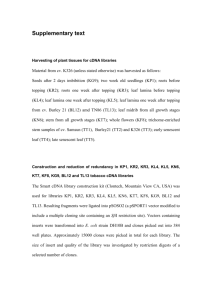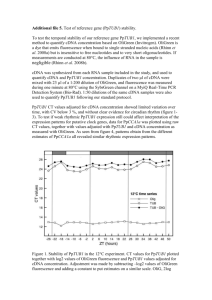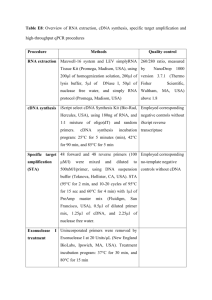Supplementary Methods Transfection normalisation Unless
advertisement
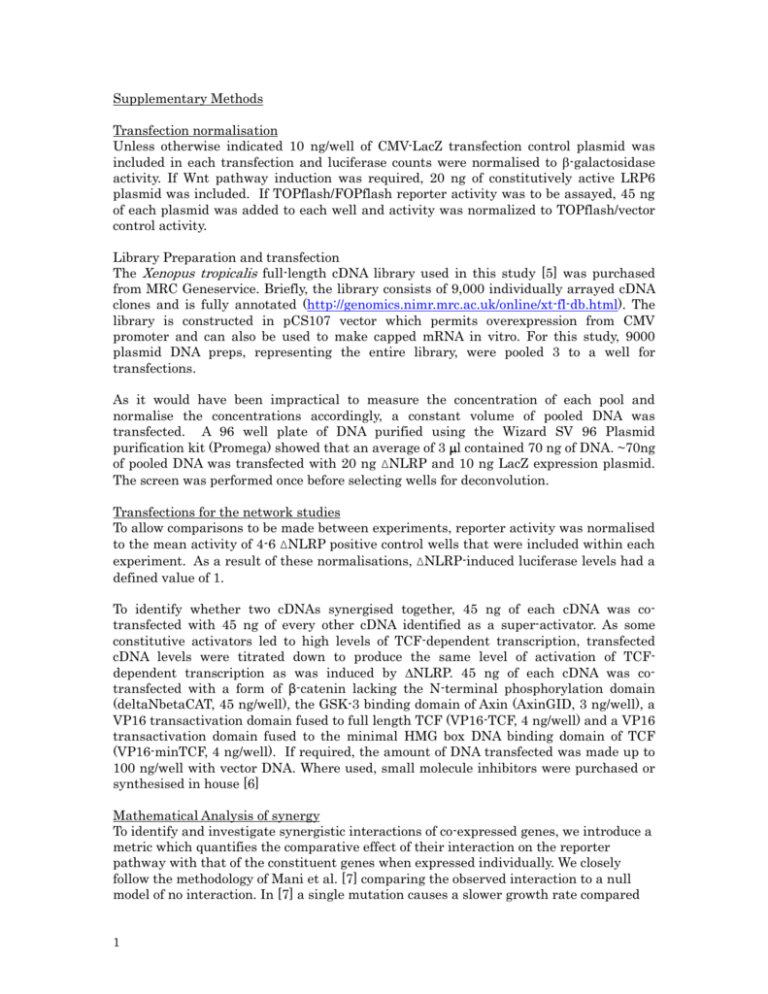
Supplementary Methods
Transfection normalisation
Unless otherwise indicated 10 ng/well of CMV-LacZ transfection control plasmid was
included in each transfection and luciferase counts were normalised to -galactosidase
activity. If Wnt pathway induction was required, 20 ng of constitutively active LRP6
plasmid was included. If TOPflash/FOPflash reporter activity was to be assayed, 45 ng
of each plasmid was added to each well and activity was normalized to TOPflash/vector
control activity.
Library Preparation and transfection
The Xenopus tropicalis full-length cDNA library used in this study [5] was purchased
from MRC Geneservice. Briefly, the library consists of 9,000 individually arrayed cDNA
clones and is fully annotated (http://genomics.nimr.mrc.ac.uk/online/xt-fl-db.html). The
library is constructed in pCS107 vector which permits overexpression from CMV
promoter and can also be used to make capped mRNA in vitro. For this study, 9000
plasmid DNA preps, representing the entire library, were pooled 3 to a well for
transfections.
As it would have been impractical to measure the concentration of each pool and
normalise the concentrations accordingly, a constant volume of pooled DNA was
transfected. A 96 well plate of DNA purified using the Wizard SV 96 Plasmid
purification kit (Promega) showed that an average of 3 l contained 70 ng of DNA. ~70ng
of pooled DNA was transfected with 20 ng ΔNLRP and 10 ng LacZ expression plasmid.
The screen was performed once before selecting wells for deconvolution.
Transfections for the network studies
To allow comparisons to be made between experiments, reporter activity was normalised
to the mean activity of 4-6 ΔNLRP positive control wells that were included within each
experiment. As a result of these normalisations, ΔNLRP-induced luciferase levels had a
defined value of 1.
To identify whether two cDNAs synergised together, 45 ng of each cDNA was cotransfected with 45 ng of every other cDNA identified as a super-activator. As some
constitutive activators led to high levels of TCF-dependent transcription, transfected
cDNA levels were titrated down to produce the same level of activation of TCFdependent transcription as was induced by NLRP. 45 ng of each cDNA was cotransfected with a form of β-catenin lacking the N-terminal phosphorylation domain
(deltaNbetaCAT, 45 ng/well), the GSK-3 binding domain of Axin (AxinGID, 3 ng/well), a
VP16 transactivation domain fused to full length TCF (VP16-TCF, 4 ng/well) and a VP16
transactivation domain fused to the minimal HMG box DNA binding domain of TCF
(VP16-minTCF, 4 ng/well). If required, the amount of DNA transfected was made up to
100 ng/well with vector DNA. Where used, small molecule inhibitors were purchased or
synthesised in house [6]
Mathematical Analysis of synergy
To identify and investigate synergistic interactions of co-expressed genes, we introduce a
metric which quantifies the comparative effect of their interaction on the reporter
pathway with that of the constituent genes when expressed individually. We closely
follow the methodology of Mani et al. [7] comparing the observed interaction to a null
model of no interaction. In [7] a single mutation causes a slower growth rate compared
1
to a wild type - mutations are deleterious. Herein, however, mutations are advantageous
by construction in comparison to a control where no cDNA is expressed necessitating a
slightly different, albeit analogous, approach.
We compare luminescence values obtained under single and pairwise cDNA
transfections comparing them to a background (control) prior to evaluating the metric.
The metric itself is then calculated using the means of the observed individual
distributions μA and μB and the pairwise μA,B. Those not significantly different from
background have their value set to the background value μC. Those with a mean less
than the background have their values set to the background value. That is, for some
cDNA, labelled A, when expressed in isolation, we obtained a set of reporter activity
(luminescence values) XA = {xA,1,...,xA,nA} for nA replicates and similarly XB
={xB,1,...,xB,nB} for some cDNA labelled B with nB replicates. The pairwise activity
levels recorded when both cDNAs were co-expressed are thus XA,B ={xA,B,1,...,xA,B,nA,B}
for nA,B replicates. Each of these three datasets was compared to a control which is
simply a set of m luminescence results, denoted Y = {y1, . . . , ym}, obtained when no
cDNA is expressed using a two-tail Kolmogorov Smirnov test at the p < 0.01 significance
S(Xa,Y) ∈ {0,1} where an outcome of 1 describes
the rejection of the null of hypothesis that XA and Y are drawn from the same
level. Writing the result of this test as
distribution (i.e. the activity of cDNA labelled A is significantly different from the
control), a mean value was assigned to the individual cDNA expression results XA
defined as
, (1)
where XA and Y are the arithmetic mean of the set of activity values XA and Y. Similar
mean values were enumerated for XB, XA,B. Consequently, those cDNA’s whose activity
was not significantly different from background (or whose mean activity was less than
the mean of the background) were assigned the control mean value, removing low-level
anomalies.
The prescribed quantitative measure of interaction, the synergistic interaction is [7]
, (2)
where fA,B is the observed fitness of the the co-transfection and E(fA,B) denotes the
expected fitness of no interaction. The measure of interaction is the deviation of the
observed behaviour compared to a model of anticipated behaviour if there was no
interaction between the genes. The co-transfection interaction fitness E(fA,B) is some
prescribed function of the individual fitnesses of each individual transfection, termed the
Neutrality Function.
As the luminescences can cover a broad range of values (up to 230μC in some cases), it
makes sense to use a logarithmic scale and, similar to the relative growth rate used in
[7], we prescribe a relative value, (i.e. as an increase compared to background), for the
fitness function,
2
. (3)
For the neutrality function, in this antithetical scenario, it is the Max function which is
appropriate,
, (4)
in contrast to the more conventional Min function [7]. Substituting the fitness and
neutrality into the synergistic interaction equation generates the definition of link
weight,
. (5)
This expression generates a positive link weight for a synergistic interaction in which
pairwise co-expressed activity was greater than both individuals (i.e. the added presence
of one of the cDNAs enhanced the activity of the other). If only one of the pair activated
when individually expressed, any increase above this would constitute a positive
interaction. Similarly, if neither cDNA led to an increase in reporter activity above
background levels when individually expressed, any reporter activity above background
levels upon co-expression would constitute a synergistic interaction.
A negative link weight was prescribed for suppressive interactions in which pairwise
activity is less than one of the individuals (i.e. the added presence of one of the cDNAs
suppressed the activity of the other). If two cDNAs were co-expressed and either (or
both) was capable of inducing reporter activity in- dividually and the pairwise activity
was lower than the maximum individual level, a negative link weight was assigned.
Alternative fitness (relative, logarithmic and both) and neutrality (max, min, log,
additional, product) functions were considered. Identification of pairwise combinations of
regulators using an alternative product rule [8] to identify synergizing pairs (WA,B =
μA,B − μAμB ), identified essentially the same set of interactions as identified using
equation 2 (454 of the 466 links). This form of analysis was not eventually used to
identify the final list of links displayed because the final approach taken produced a nonskewed data distribution centred on zero (an implicit assumption about the data
distribution) and used a fitness function that related signal to background (μC).
Importantly, the use of the alternative product model would not have altered the gene
sets studied in the overlap between functional connectome and the Wnt-protein
interaction network (Fig.7).
Derivation of the network visualisation
The network was created using a spring-based method based on the ARF layout [9].
Community Detection on the PIN
To partition the PIN we employed the Louvain method for modularity maximization [10].
This modularity maximisation method was applied to the weighted PIN network (edge
weights from the experimental dataset from STRING). The technique of modularity
maximisation seeks to identify inherent network structure through determining groups
(communities) for which the intra community linking is large in comparison to inter
3
community linking.
Community detection identified 20 different protein complexes from the set of Wnt
modulators (Louvain method for modularity maximization [10]; coloured node clusters).
It is worth noting that like any other challenging optimization problem it is quite
possible to have multiple partitions with very similar energies [1].
Glossary
The Wnt ‘Core pathway’: proteins whose function in Wnt signalling have been
established in multiple developmental contexts. In this report the following ‘core’
components were studied: LRP6, Dishevelled, Axin, -catenin and TCF.
NLRP; activated (N-terminal deletion) form of Wnt co-receptor LRP6. Inducers; cDNAs
that further increase TCF-dependent transcription induced by NLRP.
Activators; cDNAs that were activate TCF-dependent transcription when expressed
alone.
Enhancers; cDNAs that activate TCF-dependent transcription only when co-expressed
with other activators or enhancers.
TOPflash; luciferase reporter plasmid with 6X TCF binding sites.
Functional connectome; pattern of synergistic interactions between pathway regulators.
Supplementary References
1. Good BH, de Montjoye Y-A, Clauset A: Performance of modularity maximization in
practical contexts. Phys Rev E Stat Nonlin Soft Matter Phys 2010, 81:046106–046106.
2. Korinek V, Barker N, Morin PJ, van Wichen D, de Weger R, Kinzler KW, Vogelstein B,
Clevers H: Constitutive transcriptional activation by a ß-catenin-Tcf complex in APC-/- colon
carcinoma. Science 1997, 275:1784–1787.
3. Tang W, Dodge M, Gundapaneni D, Michnoff C, Roth M, Lum L: A genome-wide RNAi
screen for Wnt/beta-catenin pathway components identifies unexpected roles for TCF
transcription factors in cancer. Proc Natl Acad Sci U S A 2008, 105:9697–9702.
4. Major MB, Roberts BS, Berndt JD, Marine S, Anastas J, Chung N, Ferrer M, Yi X, StoickCooper CL, Haller von PD, Kategaya L, Chien A, Angers S, MacCoss M, Cleary MA, Arthur
WT, Moon RT: New regulators of Wnt/beta-catenin signaling revealed by integrative
molecular screening. Sci Signal 2008, 1:ra12.
5. Gilchrist MJ, Zorn AM, Voigt J, Smith JC, Papalopulu N, Amaya E: Defining a large set of
full-length clones from a Xenopus tropicalis EST project. Developmental Biology 2004,
271:498–516.
6. Ewan K, Pajak B, Stubbs M, Todd H, Barbeau O, Quevedo C, Botfield H, Young R, Ruddle
R, Samuel L, Battersby A, Raynaud F, Allen N, Wilson S, Latinkic B, Workman P, McDonald
E, Blagg J, Aherne W, Dale T: A useful approach to identify novel small-molecule inhibitors
of Wnt-dependent transcription. Cancer Res 2010, 70:5963–5973.
7. Mani R, St Onge RP, Hartman JL, Giaever G, Roth FP: Defining genetic interaction. Proc
Natl Acad Sci U S A 2008, 105:3461–3466.
8. Collins SR, Schuldiner M, Krogan NJ, Weissman JS: A strategy for extracting and
4
analyzing large-scale quantitative epistatic interaction data. Genome Biol 2006, 7:R63.
9. GEIPEL MM: SELF-ORGANIZATION APPLIED TO DYNAMIC NETWORK LAYOUT.
International Journal of Modern Physics C 2011, 18:1537–1549.
10. Blondel VD, Guillaume J-L, Lambiotte R, Lefebvre E: Fast unfolding of communities in
large networks. J Stat Mech 2008, 2008:P10008.
5
